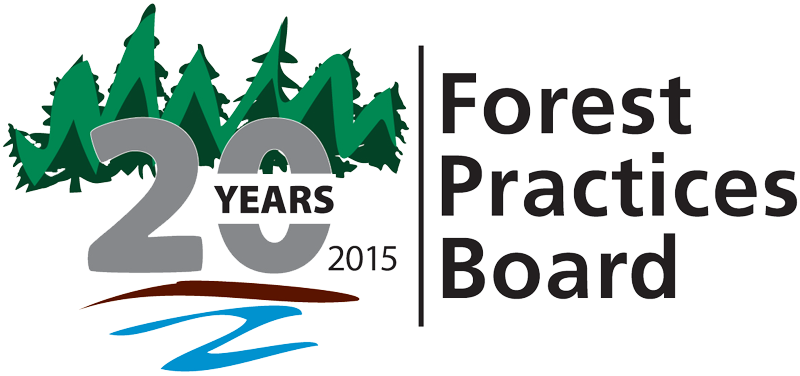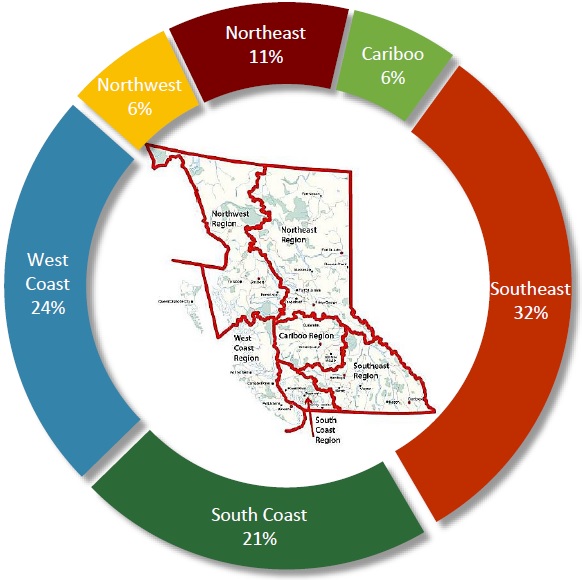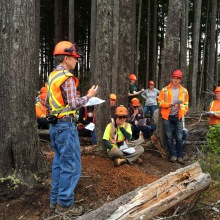 The Forest Practices Board is celebrating 20 years of service to the public and government of BC as the independent oversight of BC’s forest and range practices. The Board’s body of work is substantive and has contributed to better and more consistent practices, compliance and regulatory performance. Independent oversight is good public policy—it builds accountability, credibility and public trust. Today, independent oversight is a key piece of the public’s stewardship expectations. It also contributes to the forest industry’s social licence to access forest resources, and to the markets for BC wood products.
The Forest Practices Board is celebrating 20 years of service to the public and government of BC as the independent oversight of BC’s forest and range practices. The Board’s body of work is substantive and has contributed to better and more consistent practices, compliance and regulatory performance. Independent oversight is good public policy—it builds accountability, credibility and public trust. Today, independent oversight is a key piece of the public’s stewardship expectations. It also contributes to the forest industry’s social licence to access forest resources, and to the markets for BC wood products.
Think back 20 years to the demonstrations, civil disobedience, market boycott campaigns, and lost public confidence in forestry—the newly formed Board’s mandate was focused on the forest management issues and concerns of the day. Since then the regulatory framework and bodies have changed, but not the Board’s mandate.
The issues on the landscape have broadened as a result of cumulative effects, First Nations rights, the mountain pine beetle epidemic and environmental change. Is there an opportunity to leverage the Board’s experience, expertise and oversight beyond just forestry and ranching to across the forested landbase? Many stakeholders such as the BC Wildlife Federation, Fraser River Basin Council, Dean of the UBC Faculty of Forestry, Western Silviculture Contractors Association, Guide Outfitters Association of BC, BC Trappers Association and others think it is worth investigation. Tell us what you think.
You will see a number of interesting articles in this newsletter. I will draw your attention to the Board’s recently completed benchmarking survey of stakeholders and organizations. If you have the time, take a moment to review this survey on the Board’s website. It has provided the Board with an understanding of how it is perceived and some of the areas where the Board can make performance improvements.
Remember our door, phone and email is always open. We look forward to your comments, concerns and suggestions.
 January 2015 marked 20 years since the Forest Practices Board opened its doors for business. On June 15, 1995, the Forest Practices Code took effect and the board began to receive the first complaints under the new legislation. The Board’s ground-breaking forestry audit program was developed during 1995 for implementation in 1996. The first annual report is on the Board’s website and documents those early efforts at establishing the “public’s watchdog on effective forest management.”
January 2015 marked 20 years since the Forest Practices Board opened its doors for business. On June 15, 1995, the Forest Practices Code took effect and the board began to receive the first complaints under the new legislation. The Board’s ground-breaking forestry audit program was developed during 1995 for implementation in 1996. The first annual report is on the Board’s website and documents those early efforts at establishing the “public’s watchdog on effective forest management.”
A lot has changed in BC forest management over the past 20 years, but the basic mandate and roles of the Board carry on much the same as when it first started. Take our quiz to see how much you know about the Board. And visit https://www.bcfpb.ca/board/our-history/ for more about the Board’s history.
 Our recent survey of stakeholders and organizations with an interest in BC’s forests was a big success. We had 725 people respond to the survey from across the natural resource spectrum – government, forest industry, other resource industries, environmental groups, recreation organizations, wildlife organizations and local government. Thank-you to everyone
Our recent survey of stakeholders and organizations with an interest in BC’s forests was a big success. We had 725 people respond to the survey from across the natural resource spectrum – government, forest industry, other resource industries, environmental groups, recreation organizations, wildlife organizations and local government. Thank-you to everyone
who shared the survey and who took the time to complete it. The full results are published on our website. A few highlights identified in the survey include:
 Audit season is well underway with portions of the BC Timber Sales programs in Kamloops and Boundary audited the week of May 25th. In June, an audit of Pacific Bioenergy, a pellet producer, and RPP holdings took place near Nazko in the Quesnel District. Teal Cedar in the Chilliwack District was audited in early July, and Western Forest Products on Vancouver Island will be looked at later in the month. Two community Forests in Fort St. James will follow in August. In total, the Board plans to carry out 10 compliance audits this summer. An audit of government’s compliance and enforcement program is also in the planning stages for this fall/winter.
Audit season is well underway with portions of the BC Timber Sales programs in Kamloops and Boundary audited the week of May 25th. In June, an audit of Pacific Bioenergy, a pellet producer, and RPP holdings took place near Nazko in the Quesnel District. Teal Cedar in the Chilliwack District was audited in early July, and Western Forest Products on Vancouver Island will be looked at later in the month. Two community Forests in Fort St. James will follow in August. In total, the Board plans to carry out 10 compliance audits this summer. An audit of government’s compliance and enforcement program is also in the planning stages for this fall/winter.
 In April, the audit and investigation staff met in Port Alberni for two days of pre-season training. In addition to reviewing technology updates and safety procedures for the coming field season, they also spent some time upgrading training on visual management and visual quality objectives—a notable issue in recent Board work.
In April, the audit and investigation staff met in Port Alberni for two days of pre-season training. In addition to reviewing technology updates and safety procedures for the coming field season, they also spent some time upgrading training on visual management and visual quality objectives—a notable issue in recent Board work.
During the training session, staff became aware of some potential non-compliance with visual quality objectives in the Alberni Inlet. One of the Board’s internal policies is that if staff come across a potential non-compliance with forestry legislation during the course of its work or travels, they will consider whether there is a need to follow-up the issue to identify what happened and recommend the issue be addressed or improvements to practices be made in future. The Board has decided to investigate the matter further.

The 2015 fire season is shaping up to be a major one, as was expected following the historic low snow packs and the dry hot conditions experienced in most of BC. At the end of May, the Board released the Fuel Management in the Wildland Urban Interface-Update report, which evaluated the progress of government and communities across the province in reducing hazardous forest fuels around communities. The following week, the Board also released a summary report on the previous two years’ audit seasons, which found a strong trend of non-compliance with the fire prevention requirements of the Wildfire Act. Interest in both reports was high, with over 1180 views on our website.
To date, the fuel management report has been featured in nine news stories across the province and on radio (CKNW) and television (Global News). The board was pleased to see a strong response from the public in sharing the important findings of these reports on social media, which has helped get both reports’ messages out to the public. Information has been shared on both Facebook and Twitter and, thanks to the large number of shares and retweets by our followers, report-related content has appeared on newsfeeds over 8500 times. Stakeholders have also shared the information in their own newsletters.
The Board has a number of new reports in development. Most of these should be completed by the end of this year or early in 2016.
This report will determine the effectiveness of the Ministry of Forests Lands and Natural Resources’ FREP program in implementing continuous improvement and adaptive management as a foundation for the FRPA legislative framework. The focus for the report will be the evaluation of FREP implementation (in its design context) to determine if it is meeting, or likely to meet the expected program outcomes and fulfill its role within the FRPA framework and to provide recommendations to improve FREP design and/or delivery.
Since 2004, a number of Board complaint investigations and several audits have found results on the ground that posed risks to, or impacts on, resource values. The Board has recommended on several occasions that, in situations where risks are obvious, government needs to be able to take proactive measures before failure or conflict results. This report will draw on examples from Board investigations and audits to examine the role and decision-making authority of government’s decision-maker, the district manager for the Ministry of Forests Lands and Natural Resource Operations. The Board intends this report to highlight issues that the Board has observed and to stimulate public discussion of potential solutions.
The investigation will determine whether the parties who construct resource roads on steep terrain are meeting legislative requirements of FRPA and following professional standards of practice and the related guidelines of the professional regulatory bodies. Are the roads stable, safe for industrial and public use, constructed according to plan, and is the potential for damage to the environment being mitigated?
 Timber Removal in Mountain Caribou Habitat
Timber Removal in Mountain Caribou HabitatMountain caribou are at risk in the southern two-thirds of British Columbia. Habitat loss, habitat alteration and predation have been identified as key factors in the caribou population declines observed over the past few decades. This investigation will determine the extent of timber removal in mountain caribou habitat from harvesting, road-building, heli-landing construction, and other activities, and, the compliance of these activities with the ungulate winter range order and cutting authorities.
One of the Board’s strategic priorities is to “promote stewardship” through its reports. Stewardship is a commonly used term and is defined in many different ways. Therefore the Board decided stewardship was a topic that required an explanation in context of how the Board interprets it and how it applies in relation to our mandate. This bulletin will describe what stewardship means to the Board and how it will be assessed in the forest and range practices context.
This project will assess whether the actions taken by government and others are actually improving the area and condition of forage and whether there is a trend towards the targets set out in the 2000 Blueprint for Action for the ER Program, which specify the distribution of shrublands, open range, open forests and managed forests to be achieved by 2030. As an outcome of this work, the Board may make recommendations for future management and monitoring in the East Kootenay rangelands.

In mid-June, the Board held its annual field meeting in Northeastern BC. It has been a number of years since the Board met in the northeast and so we headed up to Fort St. John, Dawson Creek and Chetwynd to bring Board members up to speed on current issues in the northeast and how they relate to forestry and range practices. Included in the three-day trip were visits to the location for the Site C Dam, the WAC Bennett Dam, a tour of a Canfor woods operation, West Fraser’s sawmill/ bioenergy plant and woodlands, and reclamation work at the Quintette Coal Mine. The Board met with representatives from the Treaty 8 Tribal Council, the Saulteaux and West Moberly First Nations, the Oil and Gas Commission, BC Hydro, the BC Cattlemen’s Association, Canfor, West Fraser, BC Timber Sales, TECK Coal and the Ministry of Forests, Lands and Natural Resource Operations.
In May, Board Chair Tim Ryan and staff member Doug Wahl manned the Board’s booth at the BC Cattlemen’s AGM and attended a number of presentations. As the 3-day event progressed, traffic at the booth increased. Many of the cattlemen and others had heard of the FPB, and others were even more interested after the “Audit Experience” presentation that Tim Ryan gave along with Tal Pincott (Pincott Ranches Ltd.), describing the Board’s audit of two of the Pincott’s range tenures last summer.
Other meetings attended this past winter include the annual Resources North Conference, the Council of Forest Industries annual meeting in Prince George, the Association of BC Forest Professionals annual conference in Nanaimo, BC Wildlife Federation AGM in Fernie, and the Community Forests AGM in Clearwater. The Board views these events as great opportunities to meet and connect with the stakeholders most affected by our work, and to speak and present our findings to practitioners so we can help improve practices on the ground.
Board staff presented the results of our Community Watershed special investigation at the International Union of Forest Researchers (IUFRO) 4th International Conference on Forests and Water in a Changing Environment, which was held in Kelowna, BC from July 6-9, 2015. Over 4000 delegates from around the world attended the conference.
The Board will be at the Union of BC Municipalities Annual General Meeting in Vancouver on September 21 to 25, 2015. We have also submitted a proposal for a clinic or workshop on what local governments and community forests need to know about the Forest Practices Board. So stay tuned for details on that opportunity to meet with and talk to Board members and staff.



In January, Rob Volkman left the Board after many years as a contract auditor and then as an audit manager on staff, moving on to other opportunities in the private sector.
In March, we celebrated with Marvin Eng as he retired after more than 25 years with the provincial government, the last 9 years at the Forest Practices Board. Marvin is doing a small amount of contract work and enjoying time with his family.
Hannah Horn joined us in March as the new Manager of Special Investigations. A registered professional biologist, Hannah has been involved with strategic land and resource planning in BC for over 20 years as an independent consultant and as a BC government employee. She has provided process and technical support to terrestrial and marine planning processes throughout the province, including land use planning for the southern mainland, central interior, northwest, and ecosystem-based management on the Coast. She has worked with government, industry and First Nations, including landscape unit planning, old growth assessment, cumulative effects assessment, and management of focal wildlife species.
In late May, we welcomed Christine Armour, RPF, as our new Manager of Audits and Investigations. Christine has worked in forestry in BC since 1994. Most of her career, prior to joining the Board, is split between working as a consultant and as a BC government employee. With the BC government, Christine was a Compliance and Enforcement Officer in Squamish with the Ministry of Forests, Lands and Natural Resource Operations, a Senior Resource Coordination Officer on the south coast with the Ministry of Aboriginal Relations and Reconciliation, and a Planning Forester in the Cariboo region with BC Timber Sales. As a consulting Forester, Christine was involved with all aspects of timber development and silviculture.
 Test your knowledge of the Forest Practices Board. Take the quiz and submit your answers to be entered to win a prize. One entry per person. Deadline is AUGUST 31, 2015.
Test your knowledge of the Forest Practices Board. Take the quiz and submit your answers to be entered to win a prize. One entry per person. Deadline is AUGUST 31, 2015.

